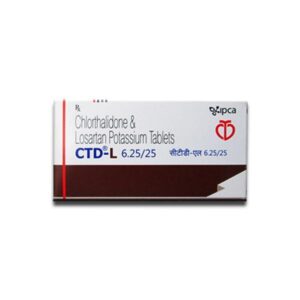LOSARTAN + CHLORTHALIDONE
Losartan: Losartan is a medication commonly prescribed for the treatment of high blood pressure (hypertension) and certain types of heart conditions, such as heart failure. It belongs to a class of drugs called angiotensin II receptor blockers (ARBs) that work by blocking the action of angiotensin II, a hormone responsible for narrowing blood vessels.
When used to manage hypertension, Losartan helps relax and widen the blood vessels, allowing blood to flow more easily and reducing blood pressure. It is also sometimes used to protect the kidneys in people with diabetes.
The usual starting dose of Losartan for hypertension is 50 milligrams (mg) once daily. However, the dose may be adjusted by a healthcare provider based on individual response. If used for heart failure, the initial dose is generally lower and may be increased gradually.
Common side effects of Losartan include dizziness, headache, fatigue, and low blood pressure. Some people may experience an allergic reaction to the drug, resulting in symptoms such as rash, itching, swelling, or difficulty breathing. It is important to seek immediate medical attention if these symptoms occur.
Losartan may also cause a slight increase in blood potassium levels, particularly in people with kidney problems. Regular monitoring of kidney function and potassium levels is recommended during treatment. Other potential side effects include gastrointestinal issues like diarrhea, abdominal pain, and nausea.
As with any medication, it is essential to follow the prescribed dose and inform your healthcare provider about any other medications or health conditions you have, as they may interact with Losartan.
Chlorthalidone: Chlorthalidone is a medication commonly used to treat high blood pressure (hypertension) and to reduce fluid retention (edema) caused by various conditions such as congestive heart failure. It belongs to a class of drugs known as thiazide diuretics.
Thiazide diuretics work by increasing the excretion of sodium and water from the kidneys, which helps to lower blood pressure and reduce fluid buildup in the body. Chlorthalidone specifically acts on the kidneys to inhibit the reabsorption of sodium and chloride ions, leading to increased urine production and subsequently reducing blood volume.
The usual starting dose of chlorthalidone for hypertension is 25 mg once daily. Depending on the response, the dose can be increased up to 100 mg per day. For edema, the typical dose ranges from 25 to 100 mg per day, taken orally. It is important to take the medication as prescribed by the doctor.
Like any medication, chlorthalidone can cause side effects, although not everyone experiences them. Common side effects may include dizziness, lightheadedness, headache, muscle cramps, weakness, and increased sensitivity to sunlight. These side effects are usually mild and temporary, but if they persist or worsen, it is important to notify a healthcare professional.
Less common but potentially serious side effects may include allergic reactions, irregular heartbeat, chest pain, joint pain, numbness or tingling, signs of kidney problems, and signs of low potassium or sodium levels. If any of these symptoms occur, immediate medical attention is necessary.
Chlorthalidone may interact with certain medications, so it is important to inform the healthcare professional about any other drugs being taken. It is also important to avoid alcohol consumption while using chlorthalidone, as alcohol may increase the likelihood of side effects.
Overall, chlorthalidone is an effective medication for treating high blood pressure and reducing fluid retention. It is crucial to follow the prescribed dose and report any side effects to a healthcare professional.

